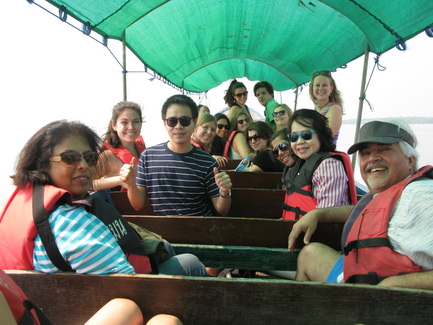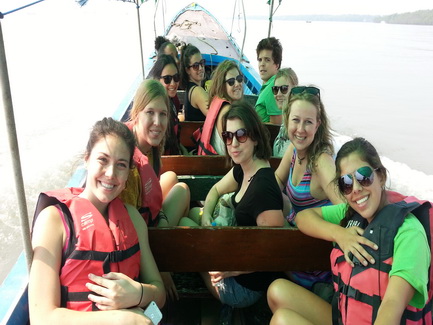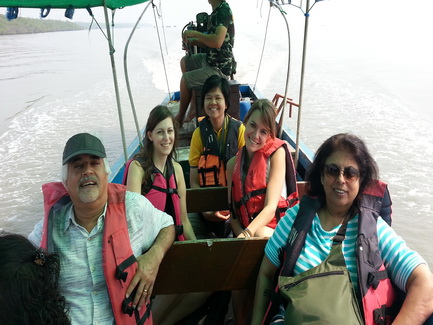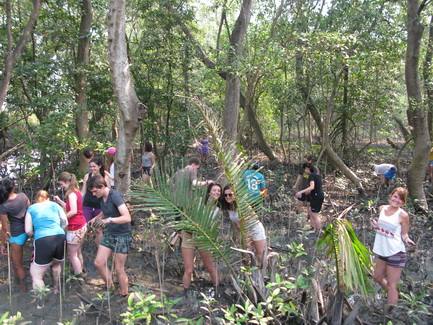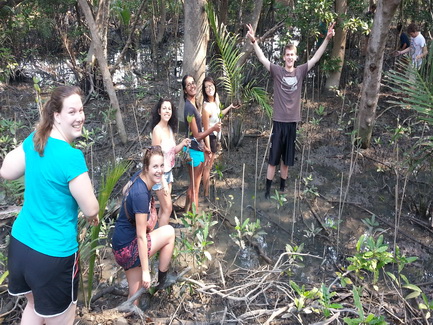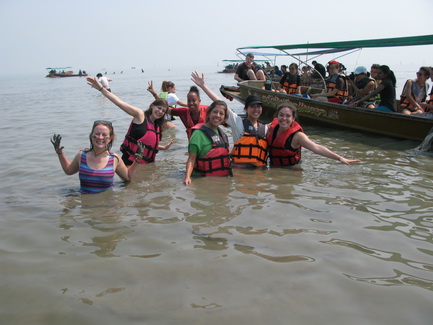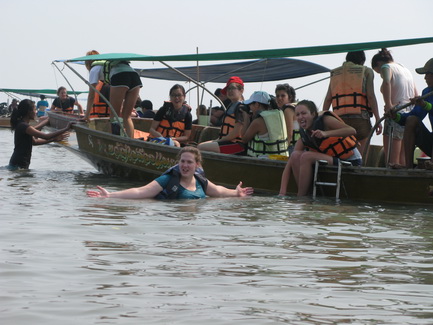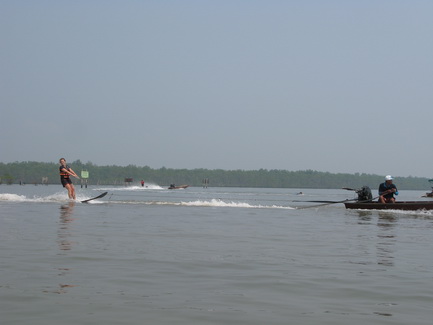Written by: Jessica Lau, an Exchange Student from University of Calgary, Canada
On Saturday, the incoming BBA exchange students went on a day trip to Klongkhone, Samutsongkram that was organized by the BBA team. All we had received were instructions to meet in front of the Administration building, to bring an extra pair of clothes and to be excited to plant some mangroves. In Alberta, Canada, we don’t have mangroves because we aren’t surrounded by any large wetland areas but there are some that grow by the bay that have adapted to our cold weather conditions. Naturally, because I’ve never even seen or heard of mangroves before, it was definitely going to be a fun experience! Properly defined, mangroves are trees that grow in tropical coastal swamps that are flooded at high tide, have numerous tangled roots above ground and form dense thickets. The roots slow the movement of which cause sediment to settle out of the water and build up as mud. They play a very crucial role in the ecosystem, as they are home to a number of plants and animals, a source of energy, and a filtration system for the saltwater. In the past few years, the substances used for shrimp farming has destroyed the mangroves and caused a significant loss of mangrove forest wetland. Since then, the community has opened up green tourism activities to encourage mangrove forest preservation and recovery, which is exactly what we did!
We arrived quite early and were greeted by our guide for the day who quickly explained the process of planting mangroves and welcomed us very warmly before allowing us to change into more appropriate clothing for the activity. We separated into 3 boats and rode along the canal, where you could see the locals’ houses built on stilts high above the water. The view from the boat was absolutely amazing and we even got to feed a few monkeys as we sped through the canal! The monkeys would run and claim their banana, run to the water and wash it before eating it, which was fun to watch! As we approached the swamp, we got ready by taking off our shoes and putting on socks (as recommended) and each got 3 mangroves to plant. Turns out, mangroves are planted in mud and it is a much more difficult task than it seems! We encountered a few problems: 1) The deep mud consumed our socks and feet with every step, as if we were sinking every time 2) It was impossible not to get dirty 3) It was hard to dig a hole for the mangrove with roots and twigs everywhere in the mud. Eventually, we were all covered in mud, did the best we could to “plant” the mangroves and sacrificed the socks we wore on the trip. The best surprise, however, was water skiing. Everyone seemed to balance well on the homemade wakeboard that brought them on huge loop around the mount. Though I did not participate, it seemed like a really fun experience and the pictures that we took looked fantastic! This was definitely a hidden gem of the organized trip, as it was left out of the schedule that Thirawut provided. The delicious lunch with 8 different dishes, ranging from tom yum soup to deep fried sea bass was so delicious and definitely the cherry on top for me. I was pleasantly surprised, as I’m sure many others were too!
The trip was definitely worthwhile, and is something not to be missed. It’s a well-organized, educational (yet fun) field trip and gives you a chance to meet everyone, and bond with those you already know. Eco-tourism is also something that I would now highly recommend as it’s off the beaten path, and provides you with a little insight on their agriculture, conservation efforts and sense of community in Klongkhone.
-------------------------------------------------------------------------------------
Written by: Ana Duque, an Exchange Student from University of Florida, USA
"On Feb. 8th, 2015, the BBA program planned a one day cultural trip to a mangrove planting activity in Samutsongkram Province for all of the BBA exchange students. The day started bright and early at 7:30am. We got on the bus and after a 1.5 hour ride we arrived at Klongkhone, where we were greeted by Puyai Joy, the owner of Puyai Joy restaurant. He welcomed our group and explained the itinerary for the day. We had a few minutes to get organized and change into clothes that we wouldn’t mind getting dirty. After taking a group picture, we were split into smaller groups and embarked on our journey into the mangroves. We got into a brightly colored, narrow boat which carried us through the canal where we were able to look at the neighborhood of houses built on the water. We felt very welcomed as some of the locals who happened to be carrying out their daily tasks waved to us form their balconies. As we got out of the canal, into the open water, we noticed that the horizon wasn’t even visible since the sky and the water looked identical. It gave a very eerie but peaceful sensation. We entered another canal where the noise of monkeys immediately caught our attention. They were very curious to see who was entering into their territory. We threw some of the bananas we had on board and watched as the monkeys frantically scrambled to get them. One of the monkeys even had the courage to swim very close to our boat to retrieve one of the bananas that had not made it to the shore. We rode deeper into the canal and parked the boat where the rest of our group was. We were each given three little mangrove trees to plant. The journey into the actual mangroves was tricky since the mud was so slippery but it was very fun and we were all successful in planting the mangrove trees which, in the end, will help this ecosystem continue to thrive. After, we washed off and boarded our respective boats. We went back to the open water and the tour guide began to explain how the water was very shallow. In fact, we were actually riding around in a shell farm. During the hot summer months there is no water in the area and the workers can easily walk around and pick up the shells. During the winter, however, the area is flooded during the day but at night time, due to the pull of the tides, the soil is exposed, allowing the workers to collect the shells. We parked the boat and waited for the water skiing activity. A friendly lady helped us get on a homemade wooden board and one by one a small speed boat took us for a loop around the lake. By far one of the most curious things we had ever seen but so much fun! After this we went back to the restaurant, changed, and enjoyed a scrumptious traditional Thai meal consisting of tom yum, crab meat, and grilled fish, among others. We could not believe how amazing the food and the overall trip was. We not only got to see a traditional Thai town outside of busy Bangkok but we also got to participate in some activities that we would have never done otherwise.
Thank you so much on behalf of all of the exchange students for the amazing experience!"

